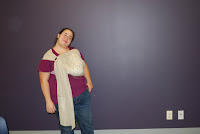What I didn't plan on, or expect, was the significance that babywearing would play in the relationship between Ansel and his father, the working parent in our family. 
We also had a lot of breastfeeding challenges, and as such, Ansel became very attached to me. Ansel was also a very "high needs" baby (see Lindsay's blog post). For the better part of his first year of life, he would not allow anyone else (including his father!) to hold him. I couldn't even leave the room Ansel was in without having him burst into tears that only I would be able to calm. My husband was admittedly quite disappointed. He and our older son had been very close from the time he was born, and he had often even preferred his father to me. We had all hoped that a similar close relationship would be present with Ansel. Having a baby that wanted nothing to do with him most of the time was very sad. I felt sad for him! But I didn't know what to do.
And then enter babywearing! We had worn our first son, Kadin(who is five years older than Ansel), at times when he was small in mainstream carriers. But primarily because the carriers were not very comfortable, we didn't wear him a lot. Even so, my husband had always loved doing it, and did it more than I did. And when Ansel was born, it was a given that he would wear Ansel as well. At some point, it occurred to me that when I needed to be apart from Ansel for some reason, like to clean the bathtub, to shower, or just to have an hour to myself, that perhaps babywearing could come into play.
carrier (which he patiently allowed me to show him how to use). Because Ansel was breastfed and did not go long between feedings, these outings were quite short, but they were my only time since his birth that he wasn't right next to me. I enjoyed the time very much, even though it was usually spent on household chores. And I very much believe that my husband enjoyed it. At times I would call him, having expected him to already be home, only to find that they were out wandering an electronics store or somewhere similarly manly. My husband would tell me that Ansel was fine, he'd fallen asleep in the carrier, so no need to rush home. Ah, the magic of babywearing!
As Ansel grew, this continued. Anytime we went out as a family, my husband insisted upon being the one to wear Ansel. I was a bit
disappointed at times, as certainly I loved wearing him, too, but this was a special time for the two of them. I was the one who got to breastfeed, I was the one who snuggled him close at night, I was the one who got to stay at home with the kids. I could give up babywearing on family outings. And as Ansel got older, he got more and more comfortable about being with his dad. The bond solidified, and my husband was happy to see that the initial rejection was not a rejection of him, but just a stage in our son's development. At 14 months, my husband even offered his services and completely took over "night duty" with Ansel and helped him to nightwean, which made my life so much easier! Without the bond and comfort they had between them from babywearing, I do not think this would have been reasonable.
Even now, with Ansel over three years old, his father is the one who wears him when we're out of the house.
My husband even wore while being sick. He was diagnosed with cancer in 2009, and while it strained many aspects of his life, he continued to wear Ansel. Certainly it would have been physically easier for him not to, as some of the medications caused him tremendous back pain, and while he wouldn't likely admit it, I believe he wanted that closeness with Ansel, even if it meant some discomfort on his part.
Babywearing offers a special opportunity to bond with your child and to spend close time. Perhaps at the end of a day of work, with so many more tasks to accomplish before bedtime, it only makes sense to multitask and combine cuddles with cooking(or cleaning!). It can lessen the challenge of being separated from your child during the day, whether you're a mother or father, a single income household or a dual income household.
Posted by: Nicole






































